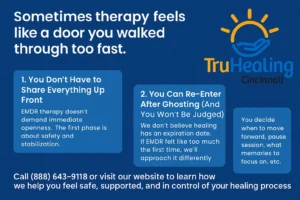Sometimes therapy feels like a door you walked through too fast.
Maybe you started EMDR, got overwhelmed, and stopped showing up. Maybe you never made it past the first intake call. Maybe you ghosted—not because you didn’t care, but because it felt too vulnerable to stay.
Here’s the truth: That doesn’t mean you failed. And it doesn’t mean you can’t come back.
At TruHealing Cincinnati, we help clients rebuild safety—especially those who paused therapy, left mid-treatment, or are afraid to open up. This blog isn’t here to push you. It’s here to gently show you that EMDR therapy can still be for you—even if you’re coming back with a few bruises and some hesitation.
1. You Don’t Have to Share Everything Up Front
If you’ve ever thought, “I’ll start therapy once I’m ready to tell the whole story,”—pause right there.
You don’t have to dump your trauma on day one. EMDR therapy doesn’t demand immediate openness. In fact, a good therapist knows that pushing for vulnerability too soon can shut people down.
The first phase of EMDR is about safety and stabilization. That might mean:
- Building trust with your therapist
- Learning grounding techniques
- Creating a “safe space” visualization
- Practicing how to pause or stop a session
This is still EMDR therapy—it just looks like preparation. And that preparation is healing.
2. You Can Re-Enter After Ghosting (And You Won’t Be Judged)
It’s common to ghost therapy. You’re not the first. You won’t be the last.
Sometimes sessions get too intense. Sometimes life happens. Sometimes you just disappear, and by the time you think about returning, shame kicks in:
“They probably think I didn’t care.”
“It’s been too long.”
“I don’t want to explain why I left.”
But here’s the thing: You don’t have to justify your absence. We don’t believe healing has an expiration date—or that missing sessions means you don’t want to heal.
At TruHealing Cincinnati, we keep the door open. Always.
If EMDR therapy felt like too much the first time, we’ll approach it differently this time. You can say, “I want to try again, but I’m scared,” and that’s enough.
3. You Are Always in Control of the Process
The idea of “reliving trauma” can make EMDR therapy sound terrifying. But what often gets missed is this:
You’re always in control.
That means:
- You decide when to move forward
- You can pause anytime during a session
- You can choose not to talk about a memory in detail
- You can focus on physical sensations instead of narrative
EMDR isn’t something a therapist does to you. It’s a collaboration. If your brain starts to flood or shut down, your therapist will help you return to calm—not push you to push through.
One TruHealing clinician put it this way:
“EMDR isn’t about digging up your trauma—it’s about teaching your brain it’s safe now.”
4. You Can Work From the Body, Not Just the Memory
For many trauma survivors, putting experiences into words isn’t just hard—it feels impossible.
That’s okay.
EMDR therapy allows you to start with what you can access. That might be a tightness in your chest, a feeling of going numb, or the sense that you’re floating outside your body when talking about the past.
These sensations aren’t distractions—they’re data. Trauma often lives in the body more than in language. Working with a body-based starting point helps many people feel safer and more grounded.
You don’t need the perfect words. You just need to feel safe enough to stay in the room.

5. Wanting to Go Slow Isn’t Weak—It’s Wise
If you’ve ever criticized yourself for not being “ready” or for needing things to move more slowly, here’s something to hold on to:
Slowness is not failure. It’s safety in action.
Many people feel broken because they can’t dive headfirst into trauma work. But that instinct—to take your time, to wait until it feels okay—isn’t resistance. It’s your brain doing exactly what it’s supposed to do: protecting you.
At TruHealing, we honor that instinct. We don’t rush. We don’t expect perfection. And we never mistake “going slow” for “not trying.”
In fact, one of the bravest things you can say is: “I’m interested… but I need to go slowly.”
6. If EMDR Didn’t Work Before, It Can Still Work Differently Now
Maybe you’ve tried EMDR before and didn’t feel anything shift.
Maybe it was rushed. Maybe the therapist didn’t feel safe. Maybe your life was in chaos and your nervous system couldn’t settle long enough to engage.
It’s okay to feel skeptical now. It’s okay to come back with boundaries, questions, or a different pace.
The right timing, the right therapist, and the right structure can make a huge difference. At TruHealing Cincinnati, our clinicians know how to work with clients who are returning after hard experiences. We believe EMDR should feel collaborative—not clinical. Empowering—not performative.
7. Here’s What EMDR Therapy Looks Like at TruHealing Cincinnati
Every EMDR client at TruHealing starts with a simple question: “What would help this feel safe?”
From there, we co-create a plan.
This might include:
- Spending several sessions on grounding before starting trauma reprocessing
- Using a variety of EMDR methods (like tactile or auditory stimulation instead of eye movements)
- Checking in constantly about pacing and comfort
- Teaching emotional regulation skills before diving into trauma content
We also recognize that trauma isn’t the only thing you’re carrying. Many clients are also managing depression, anxiety, or feeling overwhelmed by daily life. We’ll support the whole picture—not just the part that fits into a treatment model.
Not from right here? You might consider our extended support network:
- Looking for EMDR in Lexington, Kentucky? We serve that area, too.
- Closer to Louisville, KY? Let’s talk about what support looks like near you.
FAQs About EMDR Therapy (When You’re Hesitant or Returning)
Is it normal to feel afraid of EMDR therapy?
Yes. Especially if you’ve left therapy before or had a tough experience. EMDR works with deep emotions, so it’s natural to feel protective. Feeling nervous doesn’t mean you’re not ready—it just means you’re human.
What if I get overwhelmed in a session?
You can stop at any time. Your therapist will teach you how to notice early signs of overwhelm and how to pause safely. You won’t be stuck in painful memories without support.
Do I have to talk about my trauma in detail?
No. EMDR can be effective even when you don’t share everything aloud. Some people choose to focus silently on the memory while the therapist guides the process.
Can EMDR work if I have multiple traumas or complex PTSD?
Yes—but it’s often done slowly and with a lot of preparation. EMDR can be very effective for complex trauma when done by a trained, trauma-informed clinician.
I ghosted my therapist. Can I come back to EMDR without starting over?
Yes. You don’t need to start from scratch. We’ll meet you where you are and decide together what to revisit and what to build on.
Healing Is Allowed to Be Imperfect
Sometimes healing looks like showing up.
Sometimes it looks like leaving and trying again.
Sometimes it looks like saying: “I want to heal, but I’m scared.”
At TruHealing Cincinnati, that’s not weakness. That’s wisdom. That’s the part of you that still hopes—and still believes, even if only a little, that healing is possible.
And we believe that, too.
Ready to talk, even if it’s just a little?
Call (888) 643-9118 or visit TruHealing Cincinnati’s EMDR Therapy page to learn how we help you feel safe, supported, and in control of your healing process.


